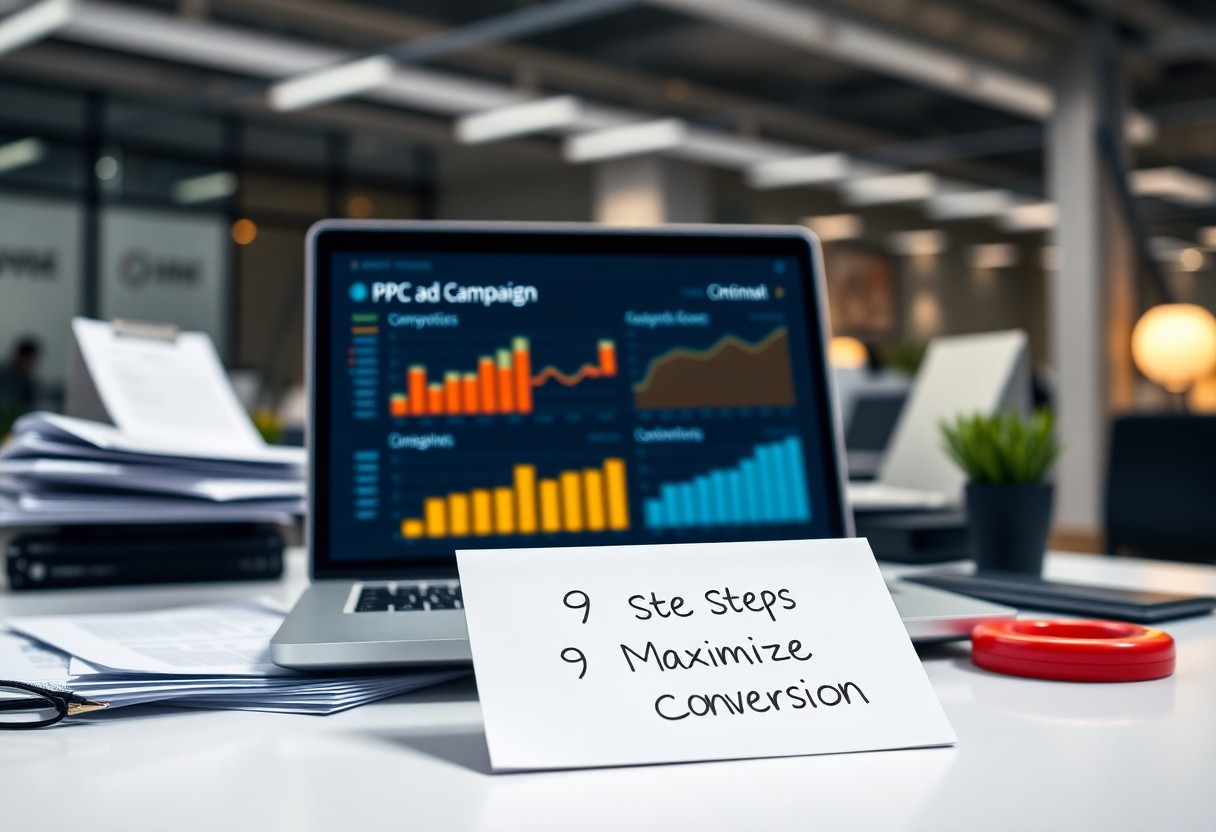PPC Advertising Cincinnati – 9 Steps To Maximize Your ROI
There’s nothing quite like stepping into the world of PPC advertising in Cincinnati, where every click can either be your best friend…
There’s nothing quite like stepping into the world of PPC advertising in Cincinnati, where every click can either be your best friend or your worst enemy. If you want to watch your return on investment (ROI) soar instead of plummet, I’ve got 9 tried-and-true steps to help you navigate this digital jungle like a pro. Get ready to unveil the secrets that will transform your ad campaigns from lackluster to fabulous—because your success is just a click away!
Key Takeaways:
- Thorough keyword research is crucial to identify high-performing terms that drive traffic and conversions.
- Regular A/B testing of ad copy and landing pages helps optimize campaigns and improve engagement rates over time.
- Utilizing negative keywords prevents wasted ad spend by filtering out irrelevant search queries that do not lead to sales.
Unmasking the Cincinnati PPC Landscape
Cincinnati’s vibrant market offers unique opportunities for PPC advertising, differing vastly from larger cities. With a blend of local interests and the region’s culture, understanding this landscape is key. I’ve found that targeting local keywords and tailoring ads to specific Cincinnati neighborhoods can significantly enhance campaign performance. Companies reaching out to community-centric audiences often see a noticeable uptick in engagement and return on investment. This city thrives on its local flavor, so being part of that conversation can position your business favorably against competitors.
The Competitive Edge of Localized Advertising
Localized advertising is more than just a trend; it’s a strategic approach that resonates with your target audience. By incorporating local elements, I’ve noticed brands gain traction quickly. Showcasing local landmarks or sponsoring community events can foster a strong brand connection, as customers appreciate relatable messaging. This authenticity tends to translate into better click-through rates and customer loyalty, ultimately sharpening your competitive edge in Cincinnati’s diverse market.
Understanding Key Metrics for Success
Knowing your key metrics isn’t just helpful; it’s the lifeblood of your PPC success. Click-through rate (CTR), conversion rate, and cost-per-click (CPC) are vital stats that show how well your campaigns are performing. For instance, a strong CTR typically indicates that your ad copy is resonating with potential customers. By constantly analyzing these metrics, I can quickly make informed adjustments to optimize campaigns, whether that means reallocating budget toward high-performing keywords or tweaking ad copy to improve appeal. Mastering these numbers helps keep my PPC campaigns aligned with my goals and maximizes returns.

Crafting Magnetic Ad Copy that Converts
Creating ad copy that demands attention is an art form that can transform your campaigns. Focus on clarity and relevance; your audience should instantly grasp what you’re offering. Use catchy headlines and emotionally charged language that resonates with potential customers. By tapping into the unique pain points of your target audience, I’ve seen campaigns boost conversions sharply. Engaging ad copy, paired with compelling visuals, can increase your click-through rates dramatically, bringing you closer to maximizing that ROI.
The Art of Telling Your Brand’s Story
A strong brand narrative sets the stage for connection with your audience. I like to weave in authenticity and relatability, making your brand feel human. Share your brand’s values, mission, and the journey that brought you here. Customers are drawn to brands that exhibit personality and passion, allowing them to relate emotionally. Just like I regularly highlight customer success stories, you should also focus on stories that reflect your brand’s essence, creating a lasting impression.
Secrets to Compelling Call-to-Actions
The magic of a well-crafted call-to-action lies in its ability to convert readers into buyers. Action verbs paired with urgency, such as “Buy Now” or “Get Your Free Trial Today,” act like a magnet for clicks. I always advise clients to test different phrasings for maximum engagement—those small tweaks can lead to substantial changes in performance. Utilizing phrases that convey exclusive offers or limited-time deals makes the reader feel they might miss out if they don’t act fast.
Transforming a simple call-to-action into a compelling one might take some finesse. Consider incorporating personalization or suggestions based on previous interactions. For instance, instead of a generic “Subscribe,” try “Join Our Community of Food Lovers!” This not only informs but invites engagement. Moreover, a clear placement, contrasting colors, and direct paths to conversion elevate your chances exponentially. Experiment with these strategies until you discover the combination that yields the highest return, making your CTA not just a click-worthy button, but a vital part of your persuasive arsenal.
Keyword Wizardry: Finding Your Golden Nuggets
Every successful PPC campaign begins with the magic of keywords. Finding those golden nuggets means tapping into the phrases and terms your audience is actively searching for. It’s necessary to think like your customer; what questions are they asking? Which problems are they trying to solve? Identifying the right keywords allows you to target your ads more effectively, ensuring your budget works harder to generate leads that convert.
The Science of Long-Tail Keywords
Long-tail keywords are the unsung heroes of PPC advertising. These multi-word phrases, while less common, often show a higher intent from searchers and less competition. For example, instead of targeting “shoes,” opting for “best running shoes for flat feet” could lead to more qualified traffic. Since they are highly specific, they not only save money on bidding but also enhance the relevance of your advertisements.
Tools to Discover What Your Audience is Searching For
Leverage various tools to uncover what your audience is truly interested in. Google Keyword Planner, Ubersuggest, and Moz Keyword Explorer are just a few that can provide valuable insights into search volumes, competition levels, and related queries. These platforms equip you with data-driven approaches to tailor your keyword strategy perfectly.
Diving deeper into these tools can really streamline your PPC efforts. For instance, Google Keyword Planner allows me to filter keywords based on different metrics—I can view the competition level and adjust my bidding strategy accordingly. Ubersuggest presents content ideas as well, linking them back to search trends, which fuels my creativity for ad copy. This way, you’re not only honing in on the terms most relevant to your offerings but also exploring diverse avenues that can connect you with a broader audience. Each keyword becomes part of a larger puzzle for crafting compelling ads aimed at driving conversions.
Budgeting Like a Pro: Dollars and Sense
Mastering your PPC budget isn’t just about throwing money at ads; it’s about strategizing for maximum impact. A well-planned budget helps steer your campaigns, ensuring you allocate resources where they deliver the best returns. Let’s explore how to set your financial game plan and use data to make smart spending decisions that can boost your bottom line.
Setting Realistic Budgets that Drive Results
Setting a budget isn’t a “one-size-fits-all” exercise. Start by assessing your business goals, the current market landscape, and your competitive stance. For example, if your aim is to increase brand awareness in Cincinnati, a modest budget could suffice, but if you’re eyeing a larger market share, you may need to go all in. Allocate funds based on your historical performance and target audiences to establish a solid foundation.
How to Adjust Your Spend Based on Data
Data is your best friend when it comes to adjusting your PPC spend. Monitor key performance indicators (KPIs) like click-through rates (CTR), conversion rates, and overall ROI to adapt your budget dynamically. By keeping a close eye on your campaigns, you can reallocate funds to top performers and cut back on underachievers. This iterative approach ensures your spending aligns with objectives and maximizes output.
For example, if you notice a particular keyword or ad group is generating a strong CTR of 10% with a solid conversion rate, consider increasing your budget for that area. Conversely, if you find your budget is going to waste in a segment with poor performance, don’t hesitate to dial it back. Implementing a bi-weekly review of your data helps instill a habit of making timely adjustments that not only stabilize your budget but also enhance your overall ROI. Always approach budget adjustments as an opportunity to refine your strategy, funneling resources into the most successful avenues and optimizing less fruitful ones.
A/B Testing: The Game-Changer You Need
Every campaign deserves a shot at glory, and A/B testing is the secret weapon to ensure yours shines bright. By pitting two versions of your ads or landing pages against each other, you can identify which elements, from headline text to call-to-action buttons, resonate better with your audience. Watch your conversion rates soar as you refine your strategy one test at a time.
Why Every Click Counts: The Importance of Testing
Each click on your ad represents a potential customer, making it imperative to maximize their impact. A/B testing allows you to see what works and what doesn’t, ensuring you don’t squander precious clicks on underperforming campaigns. With the right insights, you can improve your ads dramatically, potentially increasing your ROI by up to 300%.
Analyzing Results to Optimize Future Campaigns
After running your A/B tests, interpreting the results accurately can make or break your next move. Utilize tools that provide detailed analytics, such as conversion rates, bounce rates, and user engagement metrics. Dissect each element of your campaign to uncover hidden insights and apply them strategically in future campaigns.
Diving deeper into the analysis means not just focusing on what performed best, but understanding why it did. For instance, if one ad copy led to a higher click-through rate but lower conversions, perhaps the message resonated but failed to deliver on the landing page. I take the time to dissect user behavior, looking for patterns or themes that provide context. This approach helps refine not just ads, but overall tactics, leading to a more effective marketing strategy and improved ROI over time.
From Clicks to Clients: The End Goal
Converting clicks into clients is the ultimate objective of any PPC campaign. Each click represents a potential customer, but the journey doesn’t end there. Your challenge is to transform that interest into action, leading to profitable relationships. A strategic approach to this conversion process amplifies your success by focusing on user experience and engagement, guiding every step of your prospects’ interaction with your brand toward a satisfying conclusion. Once you’ve captured those clicks, the magic lies in what you do next.
Building Effective Landing Pages That Convert
Effective landing pages are your frontline soldiers in the battle for conversions. A well-designed landing page captures attention with a clear headline, compelling visuals, and a prominent call-to-action (CTA). Prioritize a seamless user experience that minimizes distractions while providing all necessary information. Studies show that a 1-second delay in page load time can reduce conversions by 7%. Keep it simple, focused, and aligned with your ad’s promise for best results.
The Funnel Factor: Nurturing Leads Post-Click
Just because a lead lands on your page doesn’t mean they’re ready to buy. Nurturing leads after the click is important in guiding them toward a purchase. Use various marketing tactics, such as email follow-ups, retargeting ads, and personalized content to keep your brand at the forefront of their minds. Implementing a well-thought-out funnel strategy can increase conversions by over 50%, turning passive visitors into active clients who feel valued and informed throughout their journey.
Post-click nurturing turns your one-time visitors into loyal customers by fostering relationships that encourage trust and engagement. For instance, consider adding tailored email campaigns that provide useful content or promotional offers based on the lead’s behavior and interests. Retargeting ads can remind users of their clicked products or services, reinforcing their intent. Offering value through informative content and exclusive discounts enhances their perception of your brand, ensuring they choose you over the competition when they’re ready to purchase. Social proof, like testimonials or case studies shared during this phase, further solidifies their trust in your offerings, helping you bridge the gap between a click and a conversion.
Conclusion
With this in mind, you’re all set to tackle PPC advertising in Cincinnati like a pro! By following these nine steps, I’m confident you’ll boost your ROI and make those ad dollars sing. It’s like having a secret recipe for success—who knew online ads could be this fun? So, roll up your sleeves, dive in, and let’s turn those clicks into customers! Your bank account will thank you later!
FAQ
Q1: What is PPC advertising and how does it work in Cincinnati?
A: PPC, or Pay-Per-Click advertising, is an online marketing model where advertisers pay each time a user clicks on one of their ads. In Cincinnati, businesses can utilize platforms like Google Ads or social media to create targeted advertisements that reach a specific audience. The process involves selecting keywords relevant to your business, creating engaging ad content, and setting a budget. By optimizing campaigns based on performance data, businesses can effectively increase visibility and drive traffic to their website.
Q2: What are the key steps to maximize my ROI with PPC advertising?
A: To maximize your ROI on PPC advertising, follow these nine steps: 1) Define clear objectives to guide your campaign; 2) Conduct thorough keyword research to target the right audience; 3) Create compelling ad copy that resonates with potential customers; 4) Optimize landing pages to enhance user experience; 5) Set a realistic budget while monitoring costs; 6) Use bid strategies that align with your goals; 7) Continuously analyze and adjust campaigns based on performance metrics; 8) Implement A/B testing for ads and landing pages; 9) Leverage retargeting strategies to re-engage potential customers who didn’t convert initially. These steps will help you effectively manage your ads and increase returns.
Q3: How can I track the effectiveness of my PPC campaigns in Cincinnati?
A: Tracking the effectiveness of your PPC campaigns can be done using various tools and metrics. Utilize Google Analytics to set up conversion tracking, which allows you to monitor actions taken on your website after clicking your ads. Key performance indicators (KPIs) to observe include click-through rate (CTR), conversion rate, cost per acquisition (CPA), and return on ad spend (ROAS). Regularly review and analyze these metrics to determine which ads and keywords are delivering the best results. Additionally, consider using UTM parameters to trace the performance of specific campaigns across different platforms. This level of analysis will provide insight into what strategies are working and where improvements can be made.






